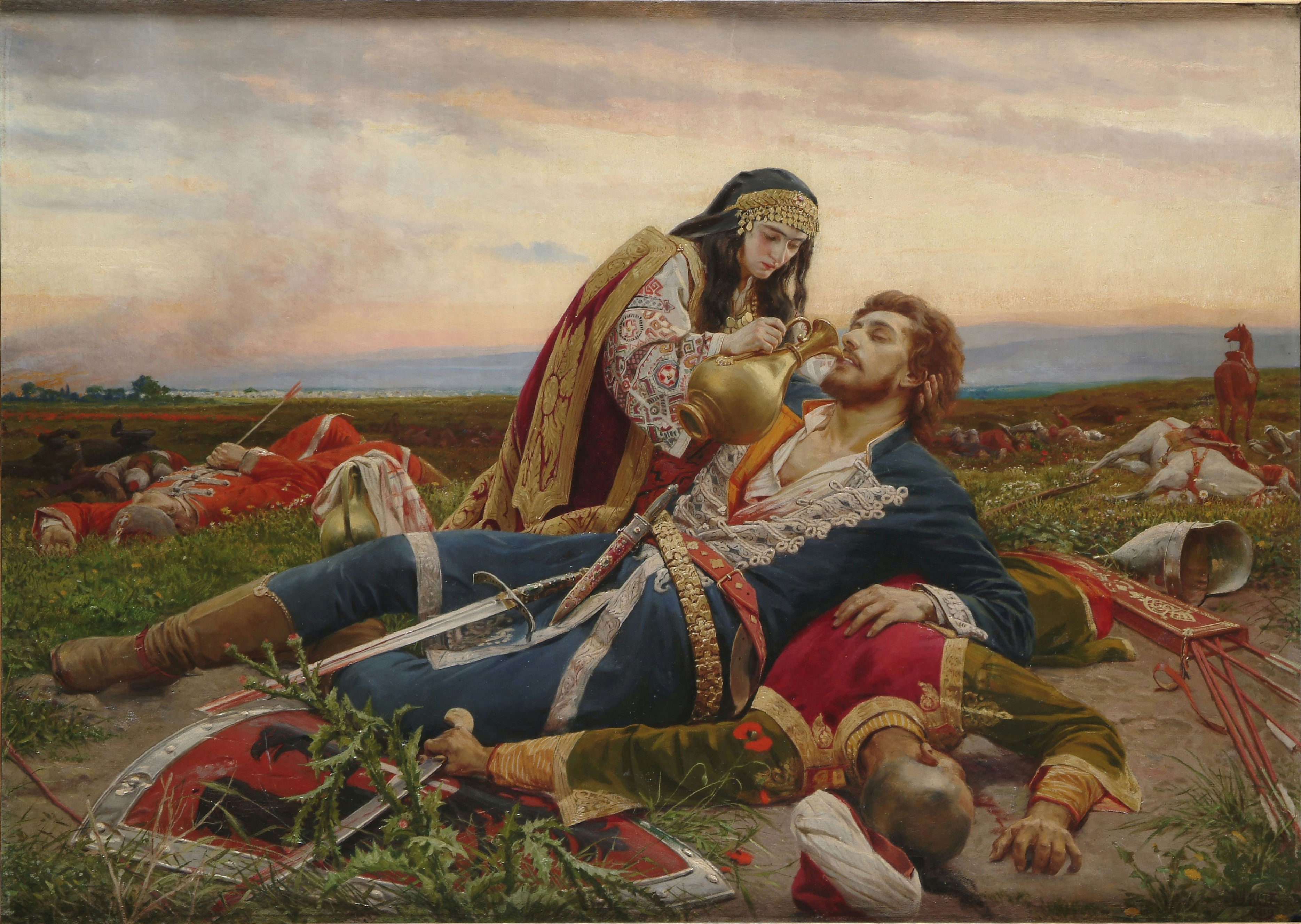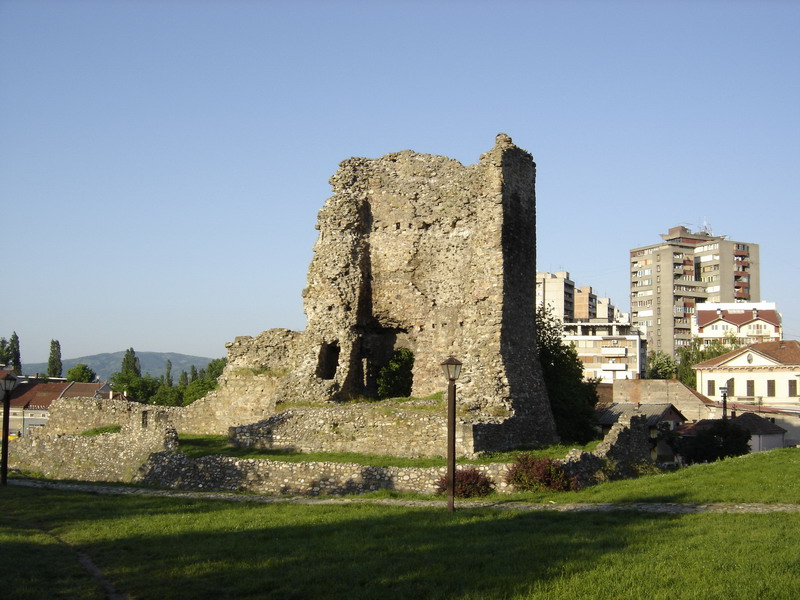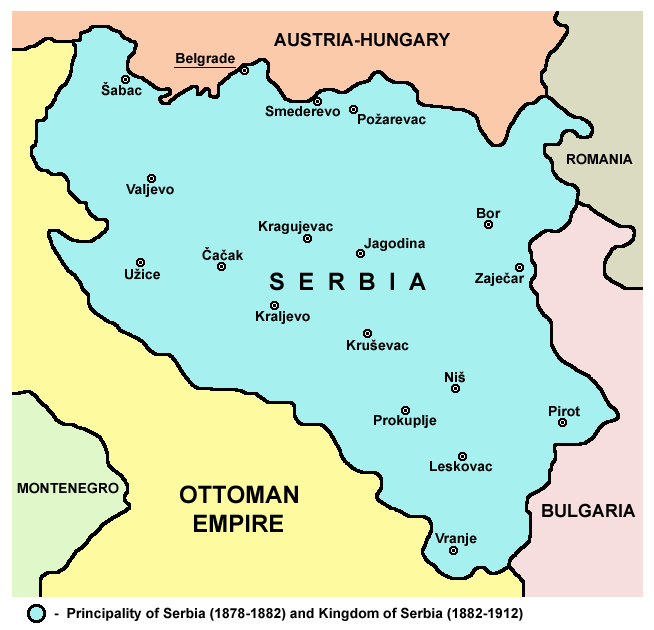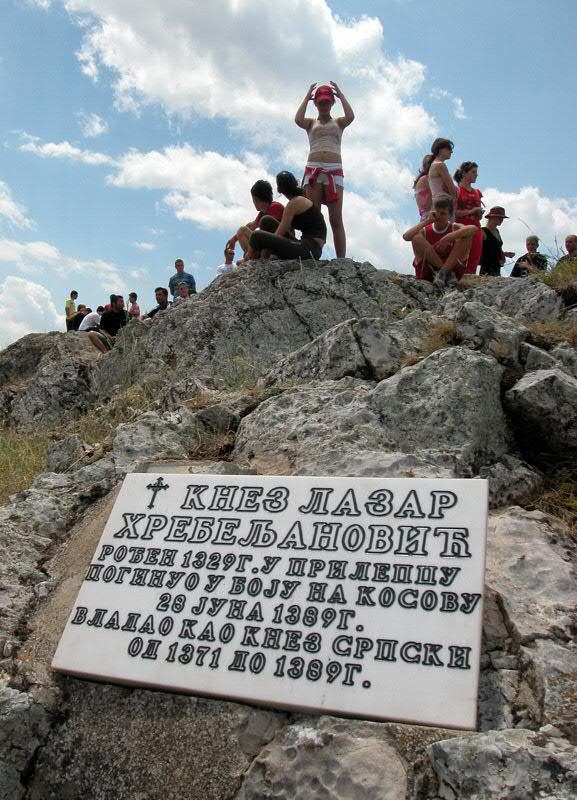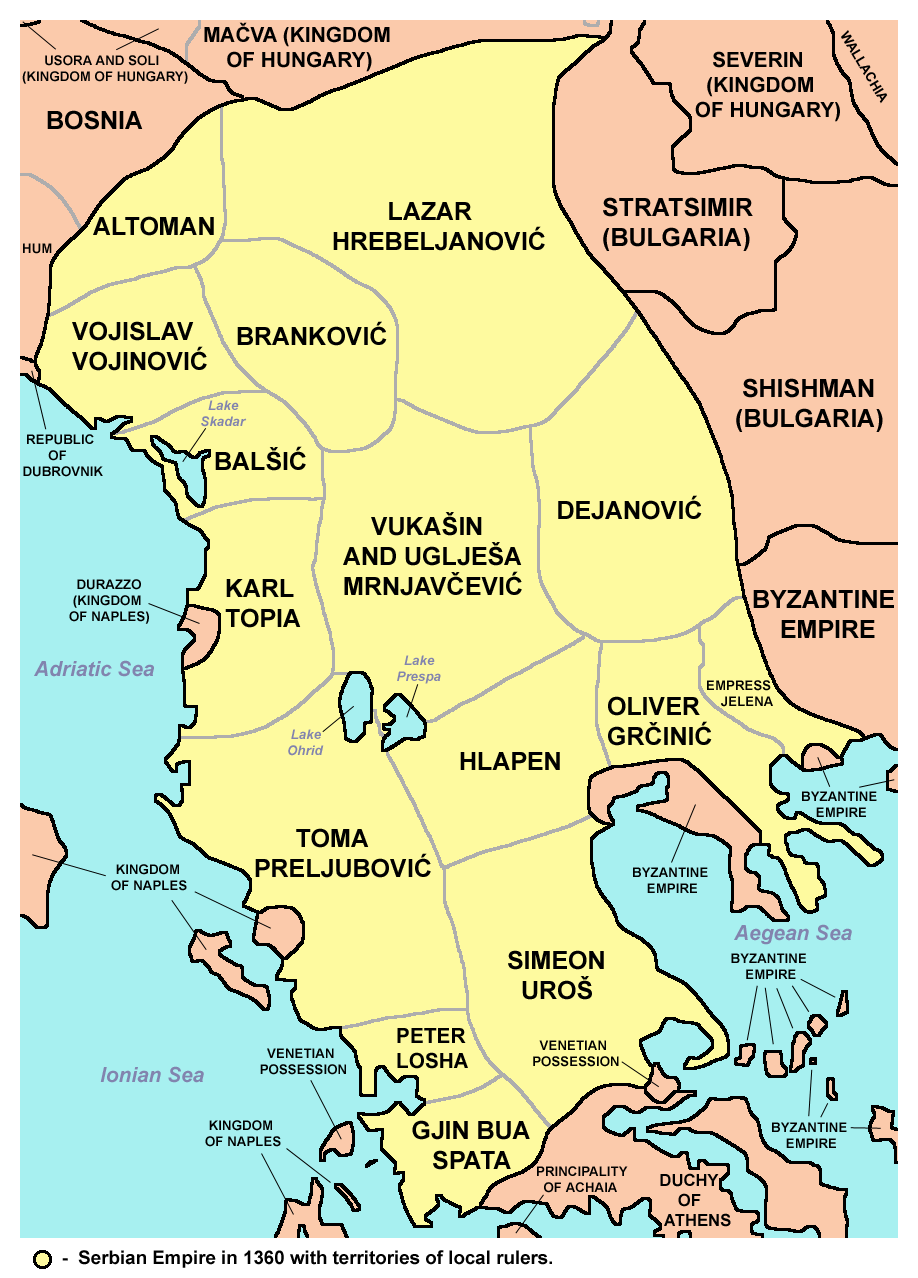|
Ottoman Serbia
Most of the territory of what is now the Republic of Serbia was part of the Ottoman Empire throughout the Early Modern period, especially Central Serbia and Southern Serbia, unlike Vojvodina which had passed to Habsburg rule starting from the end of the 17th century (with several takeovers of Central Serbia as well). In the 14th and 15th centuries, the Serbian Despotate was conquered by the Ottoman Empire as part of the Ottoman conquest of the Balkans. The Ottomans defeated the Serbs at the Battle of Maritsa in 1371, making vassals of the southern governors. Soon thereafter, Serbian Emperor Stefan Uroš V died; as he was childless and the nobility could not agree on the rightful heir, the Empire was subsequently ruled by semi-independent provincial lords, who often were in feuds with each other. The most powerful of these, Lazar of Serbia, the Duke of a region now encompassing present-day central Serbia, that had not yet fallen under Ottoman rule, confronted the Ottomans at t ... [...More Info...] [...Related Items...] OR: [Wikipedia] [Google] [Baidu] |
Stefan Lazarević
Stefan Lazarević ( sr-Cyrl, Стефан Лазаревић, 1377 – 19 July 1427), also known as Stefan the Tall ( sr, Стефан Високи / ''Stefan Visoki''), was the ruler of Serbia as prince (1389–1402) and despot (1402–1427), diplomat, legislator, ktetor, patron of the arts, poet and one of the founding members of the Order of the Dragon. The son of Prince Lazar Hrebeljanović, he was regarded as one of the finest knights and military leaders at that time. After the death of his father at Kosovo (1389), he became ruler of Moravian Serbia and ruled with his mother Milica (a Nemanjić), until he reached adulthood in 1393. Stefan led troops in several battles as an Ottoman vassal, until asserting independence after receiving the title of ''despot'' from the Byzantines in 1402. Becoming a Hungarian ally in 1403–04, he received large possessions, including the important Belgrade and Golubac Fortress. He also held the superior rank in the chivalric Order of t ... [...More Info...] [...Related Items...] OR: [Wikipedia] [Google] [Baidu] |
Flags Of The Ottoman Empire
The Ottoman Empire used various of flags, especially as naval ensigns, during its history. The star and crescent came into use in the second half of the 18th century. A ' (decree) from 1793 required that the ships of the Ottoman Navy were to use a red flag with the star and crescent in white. In 1844, a version of this flag, with a five-pointed star, was officially adopted as the Ottoman national flag. The decision to adopt a national flag was part of the ''Tanzimat'' reforms which aimed to modernize the Ottoman state in line with the laws and norms of contemporary European states and institutions. The star and crescent design later became a common element in the national flags of Ottoman successor states in the 20th century. The current flag of Turkey is essentially the same as the late Ottoman flag, but has more specific legal standardizations (regarding its measures, geometric proportions, and exact tone of red) that were introduced with the Turkish Flag Law on 29 May 1936. B ... [...More Info...] [...Related Items...] OR: [Wikipedia] [Google] [Baidu] |
Central Serbia
Central Serbia ( sr, централна Србија / centralna Srbija), also referred to as Serbia proper ( sr, link=no, ужа Србија / uža Srbija), is the region of Serbia lying outside the autonomous province of Vojvodina to the north and the disputed territory of Kosovo to the south. Central Serbia is a term of convenience, not an administrative division of Serbia as such, and does not have any form of separate administration. Broadly speaking, Central Serbia is the historical core of modern Serbia, which emerged from the Serbian Revolution (1804–17) and subsequent wars against the Ottoman Empire. In the following century, Serbia gradually expanded south, acquiring South Serbia, Kosovo, Sandžak and Vardar Macedonia, and in 1918 – following the unification and annexation of Montenegro and unification of Austro-Hungarian areas left of the Danube and Sava (Vojvodina) – it merged with other South Slavic territories into the Kingdom of Yugoslavia. The current b ... [...More Info...] [...Related Items...] OR: [Wikipedia] [Google] [Baidu] |
Banat Uprising
The Uprising in Banat was a rebellion organized and led by Serbian Orthodox bishop Teodor of Vršac and Sava Temišvarac against the Ottomans in the Eyalet of Temeşvar. The uprising broke out in 1594, in the initial stage of the Long Turkish War, and was fought by local Serbs, numbering some 5,000, who managed to quickly take over several towns in the region before being crushed by the Ottoman army. The relics of Saint Sava were burnt by the Ottomans as a retaliation. Although short-lived, it inspired future rebellions. Background Status of Serbs Ottoman crisis The reign of Suleiman I has been described as the most famous period in Ottoman history. At the end of his reign, however, the constant wars had taken its toll, damaging the economy. The faulty economic policies that followed shook the economy and with that, the foundations of Ottoman society; state officials quickly became poor, their pay being worthless ''akçe'', and corruption and bribes were common. Mutiny struck ... [...More Info...] [...Related Items...] OR: [Wikipedia] [Google] [Baidu] |
Habsburgs
The House of Habsburg (), alternatively spelled Hapsburg in Englishgerman: Haus Habsburg, ; es, Casa de Habsburgo; hu, Habsburg család, it, Casa di Asburgo, nl, Huis van Habsburg, pl, dom Habsburgów, pt, Casa de Habsburgo, la, Domus Habsburg, french: Maison des Habsbourg and also known as the House of Austriagerman: link=no, Haus Österreich, ; es, link=no, Casa de Austria; nl, Huis van Oostenrijk, pl, dom Austrii, la, Domus Austriæ, french: Maison d'Autriche; hu, Ausztria Háza; it, Casa d'Austria; pt, Casa da Áustria is one of the most prominent and important dynasties in European history. The house takes its name from Habsburg Castle, a fortress built in the 1020s in present-day Switzerland by Radbot of Klettgau, who named his fortress Habsburg. His grandson Otto II was the first to take the fortress name as his own, adding "Count of Habsburg" to his title. In 1273, Count Radbot's seventh-generation descendant Rudolph of Habsburg was elected King of the ... [...More Info...] [...Related Items...] OR: [Wikipedia] [Google] [Baidu] |
Athens
Athens ( ; el, Αθήνα, Athína ; grc, Ἀθῆναι, Athênai (pl.) ) is both the capital and largest city of Greece. With a population close to four million, it is also the seventh largest city in the European Union. Athens dominates and is the capital of the Attica region and is one of the world's oldest cities, with its recorded history spanning over 3,400 years and its earliest human presence beginning somewhere between the 11th and 7th millennia BC. Classical Athens was a powerful city-state. It was a centre for the arts, learning and philosophy, and the home of Plato's Academy and Aristotle's Lyceum. It is widely referred to as the cradle of Western civilization and the birthplace of democracy, largely because of its cultural and political influence on the European continent—particularly Ancient Rome. In modern times, Athens is a large cosmopolitan metropolis and central to economic, financial, industrial, maritime, political and cultural life in Gre ... [...More Info...] [...Related Items...] OR: [Wikipedia] [Google] [Baidu] |
Constantinople
la, Constantinopolis ota, قسطنطينيه , alternate_name = Byzantion (earlier Greek name), Nova Roma ("New Rome"), Miklagard/Miklagarth (Old Norse), Tsargrad ( Slavic), Qustantiniya (Arabic), Basileuousa ("Queen of Cities"), Megalopolis ("the Great City"), Πόλις ("the City"), Kostantiniyye or Konstantinopolis ( Turkish) , image = Byzantine Constantinople-en.png , alt = , caption = Map of Constantinople in the Byzantine period, corresponding to the modern-day Fatih district of Istanbul , map_type = Istanbul#Turkey Marmara#Turkey , map_alt = A map of Byzantine Istanbul. , map_size = 275 , map_caption = Constantinople was founded on the former site of the Greek colony of Byzantion, which today is known as Istanbul in Turkey. , coordinates = , location = Fatih, İstanbul, Turkey , region = Marmara Region , type = Imperial city , part_of = , length = , width ... [...More Info...] [...Related Items...] OR: [Wikipedia] [Google] [Baidu] |
Battle Of Kosovo
The Battle of Kosovo ( tr, Kosova Savaşı; sr, Косовска битка) took place on 15 June 1389 between an army led by the Serbian Prince Lazar Hrebeljanović and an invading army of the Ottoman Empire under the command of Sultan Murad Hüdavendigâr. The battle was fought on the Kosovo field in the territory ruled by Serbian nobleman Vuk Branković, in what is today Kosovo, about northwest of the modern city of Pristina. The army under Prince Lazar consisted of his own troops, a contingent led by Branković, and a contingent sent from Bosnia by King Tvrtko I, commanded by Vlatko Vuković. Prince Lazar was the ruler of Moravian Serbia and the most powerful among the Serbian regional lords of the time, while Branković ruled the District of Branković and other areas, recognizing Lazar as his overlord. Reliable historical accounts of the battle are scarce. The bulk of both armies were wiped out, and Lazar and Murad were killed. However, Serbian manpower was dep ... [...More Info...] [...Related Items...] OR: [Wikipedia] [Google] [Baidu] |
Lazar Of Serbia
Lazar Hrebeljanović ( sr-cyr, Лазар Хребељановић; ca. 1329 – 15 June 1389) was a medieval Serbian ruler who created the largest and most powerful state on the territory of the disintegrated Serbian Empire. Lazar's state, referred to by historians as Moravian Serbia, comprised the basins of the Great Morava, West Morava, and South Morava rivers. Lazar ruled Moravian Serbia from 1373 until his death in 1389. He sought to resurrect the Serbian Empire and place himself at its helm, claiming to be the direct successor of the Nemanjić dynasty, which went extinct in 1371 after ruling over Serbia for two centuries. Lazar's programme had the full support of the Serbian Orthodox Church, but the Serbian nobility did not recognize him as their supreme ruler. He is often referred to as Tsar Lazar Hrebeljanović ( sr, Цар Лазар Хребељановић / ''Car Lazar Hrebeljanović''); however, he only held the title of prince ( sr, link=no, кнез / '' knez'') ... [...More Info...] [...Related Items...] OR: [Wikipedia] [Google] [Baidu] |
Stefan Uroš V
Saint Stefan Uroš V ( sr-cyrl, Свети Стефан Урош V, ; 13362/4 December 1371), known in historiography and folk tradition as Uroš the Weak ( sr-cyr, Урош Нејаки, Uroš Nejaki), was the second Emperor (Tsar) of the Serbian Empire (1355–1371), and before that he was Serbian King and co-ruler (since 1346) with his father, Emperor Stefan Dušan. Early life Stefan Uroš V was the only son of Stefan Uroš IV Dušan by Helena of Bulgaria, the sister of Ivan Alexander of Bulgaria. He had been crowned as king (second highest title) in the capacity of heir and co-ruler after Dušan was crowned emperor in 1346. Although by the time of his succession as sole ruler and emperor in 1355 Stefan Uroš V was no longer a minor, he remained heavily dependent on his mother and various members of the court. Reign left, 200px, Depiction in the Serbian Orthodox Monastery of Visoki Dečani, Serbia">Visoki_Dečani.html" ;"title="Serbian Orthodox Monastery of Visoki Dečani" ... [...More Info...] [...Related Items...] OR: [Wikipedia] [Google] [Baidu] |
Ottoman Conquest Of The Balkans
A series of military conflicts between the Ottoman Empire and various European states took place from the Late Middle Ages up through the early 20th century. The earliest conflicts began during the Byzantine–Ottoman wars, waged in Anatolia in the late 13th century before entering Europe in the mid 14th century with the Bulgarian–Ottoman wars. In the mid 15th century, the Serbian–Ottoman wars and the Albanian-Turkish wars were waged by Serbia and Albania respectively against the Ottoman Turks. Much of this period was characterized by Ottoman expansion into the Balkans. The Ottoman Empire made further inroads into Central Europe in the 15th and 16th centuries, culminating in the peak of Ottoman territorial claims in Europe. The Ottoman–Venetian wars spanned four centuries, starting in 1423 and lasting until 1718. This period witnessed the fall of Negroponte in 1470, the fall of Famagusta (Cyprus) in 1571, the defeat of the Ottoman fleet at the Battle of Lepanto in 15 ... [...More Info...] [...Related Items...] OR: [Wikipedia] [Google] [Baidu] |
